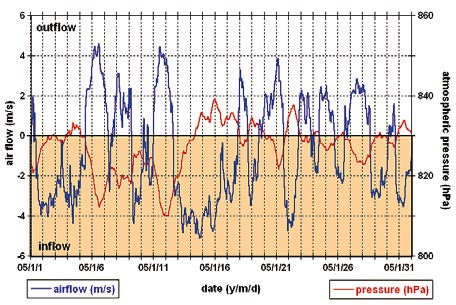Dynamic climatologic processes of barometric cave systems using the example of Jewel Cave and Wind Cave in South Dakota, USA
DOI:
https://doi.org/10.3986/ac.v39i3.75Povzetek
Jewel and Wind Cave are two big barometric cave systems in SouthDakota, USA. The entrances of Jewel and Wind Cave are roughly 50 km apart, and until now it is unknown whether their entrances belong to two separate caves or to one muchlarger cave system. One possibility for testing these two competing hypotheses is to measure and analyse the climatic conditions in the vicinity of these entrances and within the caves in detail. In this context, the thermal conditions and air currents are crucial. These in turn can be characterised by the spatial and temporal patterns of the dynamics of air entering and leaving throughthe respective entrances; even thoughthese dynamics are coupled to atmospheric pressure fluctuations outside the caves, they differ for different cave systems and provide a “fingerprint” that has implications for the size and structure of individual cave systems. To give an example, Jewel and Wind Cave as the second and fourth-largest cave systems on earthshow some similarities, but many more noticeable differences regarding their climatological behaviour, despite their close proximity to eachother. The last big measurement campaigns on the climatic systems of the two barometric caves were carried out by Herb and Jan Conn in the 1960s, (Conn 1966). Despite their elementary work, the technical possibilities were very limited in those days. The self-constructed mechanical measurement equipment could only be used for basic measurements. Herb Conn was still able to identify the basic mechanism very clearly. He also carried out a number of different calculations on barometric air flow that remain important up to the present day. During the last 40 years, rapid electronic development has enabled us to use instruments that are far more precise and sensitive. The use of ultrasonic anemometers and dataloggers enables us to take more exact long term measurements. An extensive measurement programme was started in 2001 to fulfil several researchaims, and we are now in a position to decipher the different fingerprints of the caves muchmore reliably.
Prenosi

Prenosi
Objavljeno
Kako citirati
Številka
Rubrike
Licenca
Avtorji jamčijo, da je delo njihova avtorska stvaritev, da v njem niso kršene avtorske pravice tretjih oseb ali kake druge pravice. V primeru zahtevkov tretjih oseb se avtorji zavezujejo, da bodo varovali interese založnika ter da bodo povrnili morebitno škodo.
Podrobneje v rubriki: Prispevki




